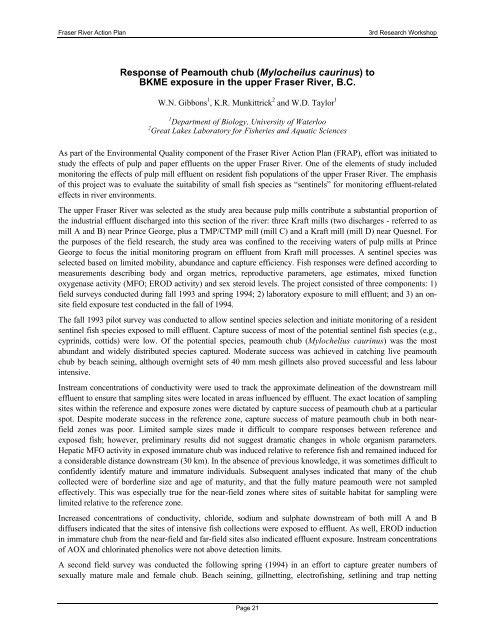Proceedings - Teaching and Learning Centre - Simon Fraser ...
Proceedings - Teaching and Learning Centre - Simon Fraser ...
Proceedings - Teaching and Learning Centre - Simon Fraser ...
You also want an ePaper? Increase the reach of your titles
YUMPU automatically turns print PDFs into web optimized ePapers that Google loves.
<strong>Fraser</strong> River Action Plan 3rd Research Workshop<br />
Response of Peamouth chub (Mylocheilus caurinus) to<br />
BKME exposure in the upper <strong>Fraser</strong> River, B.C.<br />
W.N. Gibbons 1 , K.R. Munkittrick 2 <strong>and</strong> W.D. Taylor 1<br />
1 Department of Biology, University of Waterloo<br />
2 Great Lakes Laboratory for Fisheries <strong>and</strong> Aquatic Sciences<br />
As part of the Environmental Quality component of the <strong>Fraser</strong> River Action Plan (FRAP), effort was initiated to<br />
study the effects of pulp <strong>and</strong> paper effluents on the upper <strong>Fraser</strong> River. One of the elements of study included<br />
monitoring the effects of pulp mill effluent on resident fish populations of the upper <strong>Fraser</strong> River. The emphasis<br />
of this project was to evaluate the suitability of small fish species as “sentinels” for monitoring effluent-related<br />
effects in river environments.<br />
The upper <strong>Fraser</strong> River was selected as the study area because pulp mills contribute a substantial proportion of<br />
the industrial effluent discharged into this section of the river: three Kraft mills (two discharges - referred to as<br />
mill A <strong>and</strong> B) near Prince George, plus a TMP/CTMP mill (mill C) <strong>and</strong> a Kraft mill (mill D) near Quesnel. For<br />
the purposes of the field research, the study area was confined to the receiving waters of pulp mills at Prince<br />
George to focus the initial monitoring program on effluent from Kraft mill processes. A sentinel species was<br />
selected based on limited mobility, abundance <strong>and</strong> capture efficiency. Fish responses were defined according to<br />
measurements describing body <strong>and</strong> organ metrics, reproductive parameters, age estimates, mixed function<br />
oxygenase activity (MFO; EROD activity) <strong>and</strong> sex steroid levels. The project consisted of three components: 1)<br />
field surveys conducted during fall 1993 <strong>and</strong> spring 1994; 2) laboratory exposure to mill effluent; <strong>and</strong> 3) an onsite<br />
field exposure test conducted in the fall of 1994.<br />
The fall 1993 pilot survey was conducted to allow sentinel species selection <strong>and</strong> initiate monitoring of a resident<br />
sentinel fish species exposed to mill effluent. Capture success of most of the potential sentinel fish species (e.g.,<br />
cyprinids, cottids) were low. Of the potential species, peamouth chub (Mylochelius caurinus) was the most<br />
abundant <strong>and</strong> widely distributed species captured. Moderate success was achieved in catching live peamouth<br />
chub by beach seining, although overnight sets of 40 mm mesh gillnets also proved successful <strong>and</strong> less labour<br />
intensive.<br />
Instream concentrations of conductivity were used to track the approximate delineation of the downstream mill<br />
effluent to ensure that sampling sites were located in areas influenced by effluent. The exact location of sampling<br />
sites within the reference <strong>and</strong> exposure zones were dictated by capture success of peamouth chub at a particular<br />
spot. Despite moderate success in the reference zone, capture success of mature peamouth chub in both nearfield<br />
zones was poor. Limited sample sizes made it difficult to compare responses between reference <strong>and</strong><br />
exposed fish; however, preliminary results did not suggest dramatic changes in whole organism parameters.<br />
Hepatic MFO activity in exposed immature chub was induced relative to reference fish <strong>and</strong> remained induced for<br />
a considerable distance downstream (30 km). In the absence of previous knowledge, it was sometimes difficult to<br />
confidently identify mature <strong>and</strong> immature individuals. Subsequent analyses indicated that many of the chub<br />
collected were of borderline size <strong>and</strong> age of maturity, <strong>and</strong> that the fully mature peamouth were not sampled<br />
effectively. This was especially true for the near-field zones where sites of suitable habitat for sampling were<br />
limited relative to the reference zone.<br />
Increased concentrations of conductivity, chloride, sodium <strong>and</strong> sulphate downstream of both mill A <strong>and</strong> B<br />
diffusers indicated that the sites of intensive fish collections were exposed to effluent. As well, EROD induction<br />
in immature chub from the near-field <strong>and</strong> far-field sites also indicated effluent exposure. Instream concentrations<br />
of AOX <strong>and</strong> chlorinated phenolics were not above detection limits.<br />
A second field survey was conducted the following spring (1994) in an effort to capture greater numbers of<br />
sexually mature male <strong>and</strong> female chub. Beach seining, gillnetting, electrofishing, setlining <strong>and</strong> trap netting<br />
Page 21














